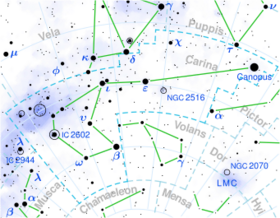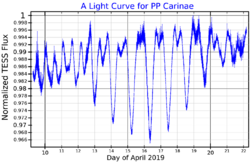Astronomy:PP Carinae
| Observation data Equinox J2000.0]] (ICRS) | |
|---|---|
| Constellation | Carina |
| Right ascension | 10h 32m 01.46297s[1] |
| Declination | –61° 41′ 07.1963″[1] |
| Apparent magnitude (V) | 3.22 - 3.55[2] |
| Characteristics | |
| Spectral type | B4 Vne[3] |
| U−B color index | –0.71[4] |
| B−V color index | –0.11[4] |
| Variable type | γ Cas[2] |
| Astrometry | |
| Radial velocity (Rv) | +26.0[5] km/s |
| Proper motion (μ) | RA: –17.01[1] mas/yr Dec.: +11.50[1] mas/yr |
| Parallax (π) | 6.75 ± 0.40[1] mas |
| Distance | 480 ± 30 ly (148 ± 9 pc) |
| Absolute magnitude (MV) | −2.684[6] |
| Details | |
| Mass | 7.6 ± 0.1[7] M☉ |
| Radius | 6.0[8] R☉ |
| Luminosity | 5,212[6] L☉ |
| Surface gravity (log g) | 3.52[8] cgs |
| Temperature | 19,291[6] K |
| Rotational velocity (v sin i) | 325[9] km/s |
| Age | 39.8 ± 7.6[7] Myr |
| Other designations | |
| Database references | |
| SIMBAD | data |
p Carinae is the Bayer designation of a star in the southern constellation of Carina. It has the variable star designation PP Carinae and, at an apparent visual magnitude of +3.3,[5] is readily visible to the naked eye from the southern hemisphere. From the observed parallax shift of this star as the Earth orbits the Sun, its distance can be estimated as roughly 480 light-years (150 parsecs) with a 6% margin of error.[1] It is considered to be a member of the open cluster IC 2602 although it lies well outside the core visible group of stars.[6]
The star is a B-type main sequence star with a stellar classification of B4 Vne.[3] The 'ne' suffix indicates it is a rapidly rotating Be star that is surrounded by hot circumstellar gas. This material adds emission lines to the spectrum of the star. It has a projected rotational velocity of 325 km s−1,[9] with about 7.6[7] times the mass and 6[8] times the radius of the Sun. This star is classified as a Gamma Cassiopeiae-type variable and its brightness varies from magnitude +3.22 to +3.55.[2]
In most versions of its asterism, the neighbouring bright stars, thus plotted along the imaginary hull forming Carina are Theta Carinae, to the south, and V337 (also known as lower case q) Carinae to the east, of second and third magnitude respectively.
References
- ↑ 1.0 1.1 1.2 1.3 1.4 1.5 van Leeuwen, F. (November 2007), "Validation of the new Hipparcos reduction", Astronomy and Astrophysics 474 (2): 653–664, doi:10.1051/0004-6361:20078357, Bibcode: 2007A&A...474..653V.
- ↑ 2.0 2.1 2.2 Otero, Sebastian Alberto (15 April 2012). "VSX: Detail for PP Carinae". The International Variable Star Index. American Association of Variable Star Observers. https://www.aavso.org/vsx/index.php?view=detail.top&oid=6067.
- ↑ 3.0 3.1 Houk, Nancy (1978), "Michigan catalogue of two dimensional spectral types for the HD stars", University of Michigan Catalogue of two-dimensional spectral types for the HD stars. Volume I. Declinations -90_ to -53_ƒ0 (Ann Arbor: Dept. of Astronomy, University of Michigan) 1, Bibcode: 1975mcts.book.....H.
- ↑ 4.0 4.1 Feinstein, A.; Marraco, H. G. (November 1979), "The photometric behavior of Be Stars", Astronomical Journal 84: 1713–1725, doi:10.1086/112600, Bibcode: 1979AJ.....84.1713F.
- ↑ 5.0 5.1 Wielen, R. et al. (1999), "Sixth Catalogue of Fundamental Stars (FK6). Part I. Basic fundamental stars with direct solutions", Veröff. Astron. Rechen-Inst. Heidelb (Astronomisches Rechen-Institut Heidelberg) 35 (35): 1, Bibcode: 1999VeARI..35....1W.
- ↑ 6.0 6.1 6.2 6.3 Silaj, J; Landstreet, J. D (2014). "Accurate age determinations of several nearby open clusters containing magnetic Ap stars". Astronomy & Astrophysics 566: A132. doi:10.1051/0004-6361/201321468. Bibcode: 2014A&A...566A.132S.
- ↑ 7.0 7.1 7.2 Tetzlaff, N.; Neuhäuser, R.; Hohle, M. M. (January 2011), "A catalogue of young runaway Hipparcos stars within 3 kpc from the Sun", Monthly Notices of the Royal Astronomical Society 410 (1): 190–200, doi:10.1111/j.1365-2966.2010.17434.x, Bibcode: 2011MNRAS.410..190T.
- ↑ 8.0 8.1 8.2 Meilland, A.; Stee, Ph.; Chesneau, O.; Jones, C. (October 2009), "VLTI/MIDI observations of 7 classical Be stars", Astronomy and Astrophysics 505 (2): 687–693, doi:10.1051/0004-6361/200911960, Bibcode: 2009A&A...505..687M.
- ↑ 9.0 9.1 Bernacca, P. L.; Perinotto, M. (1970), "A catalogue of stellar rotational velocities", Contributi Osservatorio Astronomico di Padova in Asiago 239 (1), Bibcode: 1970CoAsi.239....1B.
- ↑ "MAST: Barbara A. Mikulski Archive for Space Telescopes". Space Telescope Science Institute. https://mast.stsci.edu/portal/Mashup/Clients/Mast/Portal.html.
 |



